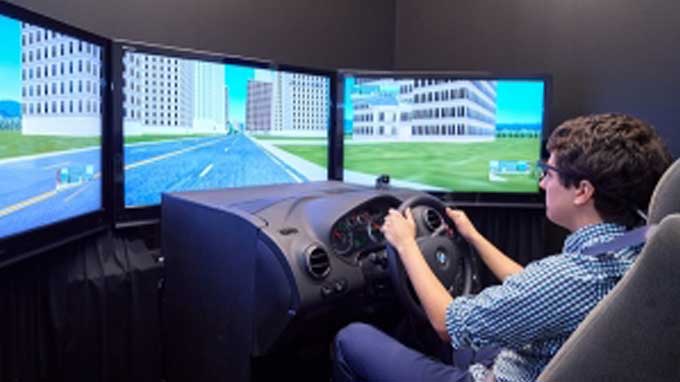

Who will be affected by visually-induced motion sickness (VIMS) is still hard to predict.
Driving, specifically teen driving, is a research focus area for the Center for Injury Research and Prevention (CIRP) since motor vehicle crashes continue to be the leading cause of death for adolescents in the US. Our researchers use several tools to investigate driving behaviors, including naturalistic (in-vehicle) driving data, crash test dummies, computer models, and simulated driving. Each comes with benefits and drawbacks that researchers must consider when designing their experiments.
As the coordinator of the CIRP Driving Simulator Core, I help conduct research using both our high-fidelity, fixed base driving simulator and our mobile driving simulators. While driving simulation offers researchers a safe, reproducible environment to test unsafe driving behaviors and events, such as pedestrians stepping out in front of a vehicle, this research tool has some drawbacks as well.
Even the most advanced driving simulators cannot provide the same experience as driving a real car on a real road, and research participants experiencing visually-induced motion sickness (VIMS), also known as “simulator sickness," can cause delays in data collection for studies. When I heard that Behrang Keshavarz, PhD, a scientist with the University Health Network Toronto Rehab Institute’s Safe Independent Mobility Lab, would be giving a talk at CIRP on VIMS, I was excited to attend.
Dr. Keshavarz and his team are working to better understand VIMS, who may be susceptible, and methods to help reduce or prevent it. VIMS is a type of motion sickness that is induced by visual stimuli and can be caused by simulators, video games, virtual reality, or even IMAX movies.
Although no one is certain as to why VIMS occurs, the leading theory points to sensory conflict: that is, your eyes are telling your brain you’re moving, but your body’s other senses (most notably the inner ear’s balancing input and your muscles' input as you move through space) are telling your brain you’re sitting still. This mismatch of sensory input can lead people to experience the same symptoms as “real” motion sickness: nausea, sweating, vomiting, fatigue, and dizziness.
Dr. Keshavarz made an important point that since people who experience VIMS can get used to simulators and no longer experience symptoms, this may be more about expectations of movement rather than a sensory conflict. For instance, they may experience VIMS the first time driving in a simulator but after a few minutes may feel fine because they have learned what the movement experience is like.
While there are no clear-cut indicators of who will experience VIMS, trends point to susceptibility seen across a variety of simulation research based on both personal characteristics and simulator characteristics:
It’s also interesting to note that some people who vomit due to VIMS report less overall effects of motion sickness; that is, they may have felt very mild symptoms (if any) but vomited, while others who experience severe symptoms may not vomit. It’s therefore unclear, and at this time not truly possible to determine, who will experience VIMS and who will not.
While we can take the above susceptibilities and simulator characteristics into account to help reduce VIMS, Dr. Keshavarz believes researchers may want to consider other tactics to help prevent VIMS:
Overall, visually-induced motion sickness is a complex phenomenon that is not currently fully understood. Although there are a few ways we can help reduce VIMS, it cannot be fully eliminated. The best way to combat VIMS is still habituation: Let the person get used to the simulator before beginning testing.